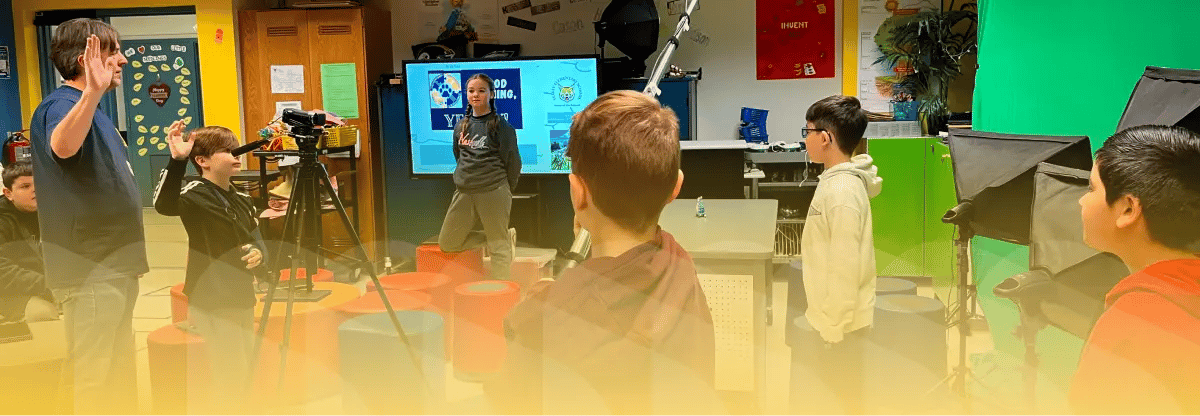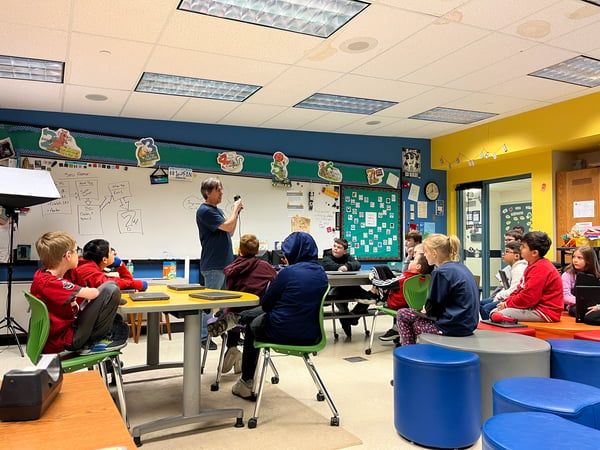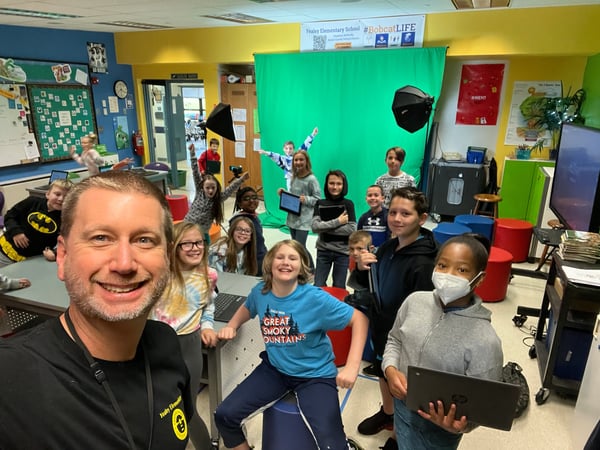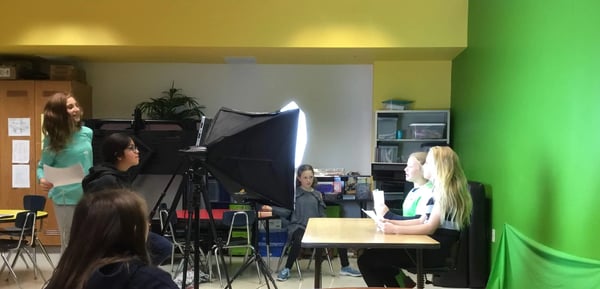
I started teaching at Yealey Elementary School in 2016, replacing one of the resident tech experts, and everyone had the same idea: "Do a news program!"
Easier said than done. At the time, I didn't feel proficient enough in video production, and a handful of past attempts at producing a news program never really got off the ground. I was eager to try new, multimedia-driven ideas, but wasn't sure what they could be.
Then I discovered WeVideo — almost by accident — that same fall. I was observing at one of our district’s middle schools and witnessed eighth grade students creating videos to summarize their history unit. Once I created my own account and saw just how easy WeVideo was to use, my lack of a video production background seemingly disappeared.
I had my multimedia creation tool; now it was time to start exploring its applications with students!
The early years
In 2018, our school started a journey with The Leader In Me, a schoolwide approach to teaching the Seven Habits of Highly Effective People to kids. By then, I was a full-time teacher plus part-time social media coordinator for Yealey (you know how it goes…). I knew that I needed students’ support in sharing what we were doing at school with their parents, and I felt like video was the best way to do so.
So, a news program? Not exactly. Instead, I started Yealey’s first ever video club.
A large part of The Leader In Me revolves around empowering students to take on leadership roles. Video Club would allow me to do just that, while also teaching our kids how to tell Yealey’s story — from their perspectives.
.webp?width=600&height=600&name=Collage%20of%20Yealey%20Video%20Club%20Students%20(1).webp) Video Club has helped my students tell stories from their eyes.
Video Club has helped my students tell stories from their eyes.
In Year One, I planned on having 12 students in the club. By then, I had worked with enough of them in other classes to know who had a knack for technical work, but I didn’t want to just handpick participants.
Instead, I had all interested students complete an application and an interview, then I selected 12. We met once per week before school and learned the basics of video editing, then used these skills to communicate the 7 Habits with parents, or to stage interviews with other teachers.
All was well…
But, as a teacher, you know that your students’ objectives are rarely your own, and oftentimes we need to adjust our plans to fit the audience.
Turns out — a lot of kids want to be the next big YouTuber or TikToker. They aren’t interested in telling the school’s story, but do want to learn video editing and filmmaking skills. It took me a year or two (and a worldwide pandemic) to realize this, but in the end, learning and adjusting is what got us to where we are today.
About the pandemic
The COVID years were weird for everyone, but especially teachers. We all have stories we can tell, but one of my favorites is the virtual video club we created for the 2020-21 school year. I asked parents if their children would be interested in a virtual club, knowing that many of us were Zoomed out already. I got a resounding YES, and we went about meeting an hour before school, two days a week, on Google Meet to show off our video projects.
This quickly became my favorite part of school during the pandemic. I thoroughly enjoyed leading discussions with my young video editors. They’d log on to meetings with their latest videos ready to show off. We watched, then took turns offering feedback. This was the purest time I’ve ever experienced as an educator, where creative minds came together with the goal of sharing and learning from others. I even started sharing my own videos with students to get their feedback as well.
The challenge, of course, was that the pandemic was…long. Cut to a couple months later, and we were right back to virtual learning fatigue, with my students lacking the knowledge needed to transform their ideas into high-quality content. As a group, we needed to be more intentional about what we were creating, and how we were doing it.
I built future assignments around various aspects of video production, creating my own exemplar and how-to videos in order to teach the skills that my students needed. This model has served me well — creation is such an open-ended process that it’s easy to forget that we still need structure in the experience. Building intentional skill development into our weekly meetings pushed the club forward.
Something else that helped — not doing this alone. Before COVID, even when Video Club was just a concept in my mind, a colleague introduced me to Scott, a parent of one of her students.
Scott writes code for a living but has a video studio in his basement and loves teaching "nerd" skills to kids. He graciously agreed to help me and has been my right-hand man for years. Even after both of his kids have transitioned to middle AND high school!
 Scott's a crucial voice in Video Club!
Scott's a crucial voice in Video Club!
I've also recruited two other teachers in the past few years to assist on a regular basis. The lesson here — a project like this doesn't grow in a silo; it's the combined efforts of several educators and a bunch of eager students that make the wheels turn.
Growing pains
COVID aside, there have been plenty of other growing pains. Literally.
Over the years, Video Club’s popularity has accelerated. Today, it’s hard to limit the group to just 12 students.
Recently, I removed the application process and told parents that if they paid $20, their child could join the club (and get a free t-shirt!). Great idea. Right?
I wound up with 38 kids.
Don't get me wrong, it was great for budget and hype, but hard to manage that many kids. Plus, I found that a large percentage of the kids enjoyed coming to school early to play games on their Chromebooks and hang out with friends, but they weren’t interested in making videos. I had to come up with a way to find kids who were interested in video production.
So, I turned back to my day job.
I tell people that I teach elementary technology, but not what you think. My day is filled with robots, coding, video, eBooks, and VR. In my curriculum, I’ve devised a badge program that helps my students stay focused as they work with robots or other tools and keeps them moving forward and learning new skills.
I’ve shared this badge program at a number of conferences and it has transformed how I approach teaching any new technology tool. I envision what I want an expert to be able to do, then break it down into various skills. Then I create assignments so students can demonstrate that skill to me and earn a badge. In theory, a student can pick up this program at any grade level and progress along the path to expertise at their own pace.
Then I realized, what if I did this for Video Club?
This year, I implemented Video Club-specific badges. Students who signed up for Video Club had to complete three badges between September and December in order to continue in the program, graduating to Video Club Masters along the way.
 Video Club has grown every year, both in numbers and engagement.
Video Club has grown every year, both in numbers and engagement.
I’m happy to report that as of this writing, 25 out of 35 members are now Masters and are continuing their video journey with me, meeting together twice a week before school. As time goes on, I want to create a total of ten badges, plus incorporate the WeVideo Student Certification program, to grow kids from video novices to seasoned experts who can use their own ideas and past experiences to create the videos they want to make.
What we're learning
You may be wondering what skills students learn when working with video. So far, we’ve covered basic principles around green screen, the 180 Rule, Rule of Thirds, voiceover, and animated text. We also learn how to set up and run a camera, as well as upload footage to WeVideo. There's a lot to unpack.
 Learning how to become professional videographers.
Learning how to become professional videographers.
We have plenty of fun too. In the spring of 2021, as the world was slowly coming out of the pandemic, rules were loosening, but we still had to be careful about large gatherings indoors. Our annual school talent show had to be done virtually, and our staff act had to be done as a video. Our music teacher wanted to do a flash mob Macarena for our act. Enter Video Club to help get it done. We all gathered on the playground after school and our Video Club helped film the event.
Additionally, Scott creates an epic project each year that uses the kids as actors and film crew. He teaches them so much about the production of a project than I ever could. Last year, we explored a wormhole a student brought in for show and tell. This year, we’ll be experiencing the catacombs under our school.
WATCH:
- Under the Mask, a video created by Yealey students during the pandemic
- Yealey Elementary's Video Club playlist, 2022-2023
- Yealey Elementary's Video Club playlist, 2023-2024
Our club is a rare thing. I find that people are surprised that I have dozens of elementary kids creating video content on a regular basis. People expect this of high school students, but not elementary students.
 Yes — elementary school students can make amazing video content.
Yes — elementary school students can make amazing video content.
When I started Video Club, a local nonprofit hosted a red carpet event to celebrate high school videos. I informed them that my students would also participate, which surprised them a bit. No matter. We won a PSA award because my kids are awesome!
Every year, PTA hosts a Reflections contest, with an annual theme and contests in various media. A few years ago, one of my students won a national award for her video about how she plans to change the world.
I’m proud of all my students. Sometimes I sit and think that I’m asking eight, nine, and ten-year olds to create epic videos that we can post on our school’s social media sites. It's truly mind-boggling. That speaks to the ease of use of WeVideo and the creativity and grit of my students.
So if you're interested in using multimedia in the classroom, but unsure of where to start, I hope this piece has given you the answer. With a quality editing tool, a few ideas, and a group of excited students, you too can introduce the magic of multimedia creation to your school!
Create your own video club with WeVideo

Craig Dunlap is the Blended Learning Teacher at Yealey Elementary School in Florence, KY. He loves teaching students about robotics, coding, digital storytelling, and especially video production. Craig's favorite place is outside — whether on a hiking trail or on a beach — with his family. He is a frequent presenter at KySTE and ISTE. Craig is an ambassador for both WeVideo, Cubelets, and ClassVR, and was the 2021 Kentucky Technology Teacher of the Year.
Craig is an ambassador for both WeVideo and Kodable and was the 2021 Kentucky Technology Teacher of the Year.